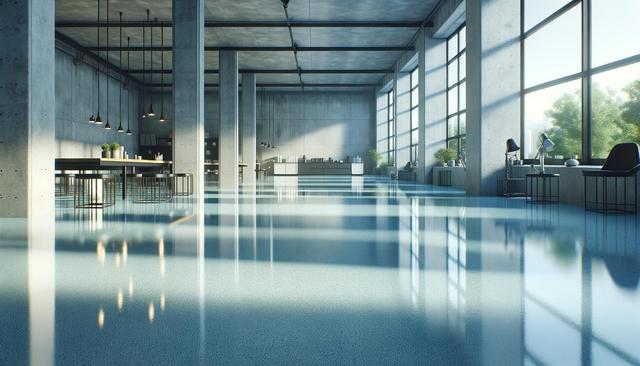What is Epoxy Flooring?
Epoxy flooring is a type of surface coating made by mixing resin and hardener to create a strong, adhesive material. This chemical reaction results in a durable plastic-like surface that bonds tightly to concrete floors. Originally used in industrial settings, epoxy flooring has gained traction in residential garages, basements, kitchens, and even living rooms due to its modern aesthetic and resilience. It forms a smooth, high-gloss finish that can be customized with different colors, textures, and effects.
There are different types of epoxy flooring systems, each serving specific needs. These include:
- Self-leveling epoxy for smooth surfaces in commercial and residential areas
- Mortar epoxy for heavy-duty industrial use
- Graveled epoxy for decorative options with colored flakes
- Antistatic epoxy for areas requiring protection against electrical charges
The versatility of epoxy flooring makes it suitable for a wide range of applications, from warehouses to stylish home interiors. Its seamless surface also helps improve hygiene by preventing the accumulation of dirt and bacteria in cracks or grout lines.
Durability and Longevity
One of the most appealing features of epoxy flooring is its long-lasting durability. The material is highly resistant to wear and tear, which makes it ideal for high-traffic areas. Whether it’s constant foot traffic in commercial spaces or the weight of vehicles in a home garage, epoxy can withstand it without cracking or peeling.
Additional durability benefits include:
- Resistance to chemicals, oil, and gasoline
- Waterproof properties that prevent moisture damage
- Scratch and impact resistance
These properties contribute to epoxy flooring’s longevity, often lasting 10-20 years with proper care. The cost-effectiveness over time makes it a practical investment for property owners looking to minimize repair and replacement expenses.
Low Maintenance and Easy Cleaning
Maintaining an epoxy floor is relatively straightforward. The seamless surface prevents dirt and spills from seeping into cracks, making cleaning quick and efficient. Regular sweeping or vacuuming, combined with occasional mopping using a mild detergent, is generally sufficient to keep the floor looking new.
Its resistance to stains and spills is particularly beneficial in environments prone to messes, such as kitchens, workshops, or garages. This low-maintenance aspect appeals to homeowners and business operators alike who prefer long-term convenience over time-consuming upkeep.
Furthermore, epoxy flooring does not require waxing or polishing. This saves both time and money on additional cleaning products or specialized services. The high-gloss finish also reflects light, which can brighten up a room and reduce lighting costs in larger spaces.
Design Flexibility and Aesthetic Appeal
Epoxy flooring is not only practical but also highly customizable. It offers a wide range of design options, allowing users to personalize their space according to their preferences. From solid colors to metallic finishes and decorative flakes, epoxy can be tailored to complement various interior styles.
Common aesthetic options include:
- Marble-like finishes for a luxurious appearance
- Color flakes for added texture and grip
- Metallic pigments for a modern, reflective look
This design flexibility makes epoxy a popular choice for showrooms, retail stores, and even residential living areas seeking a contemporary edge. With proper planning, epoxy flooring can be both a functional and visually striking feature of any space.
Installation Considerations and Professional Help
While epoxy flooring offers numerous benefits, proper installation is crucial to achieving desired results. Surface preparation is essential—concrete must be clean, dry, and free from cracks or oil stains. Failing to prepare the base properly can result in peeling or bubbling over time.
Although DIY epoxy kits are available, hiring professionals is often recommended for larger or more complex projects. They bring the expertise and tools necessary to ensure a smooth, even application. Professionals can also advise on the right type of epoxy system based on specific needs, such as slip resistance or chemical exposure.
Before installation, consider factors like:
- Drying and curing time (usually 24-72 hours)
- Ventilation requirements during application
- Temperature and humidity conditions
Understanding these elements helps ensure a successful and long-lasting floor coating, making it a worthwhile investment for any property.
Conclusion
Whether for a residential garage, a commercial workspace, or a decorative interior, epoxy flooring offers a compelling combination of strength, style, and simplicity. Its durability, ease of maintenance, and customizable appearance make it a practical choice for many settings. By investing in a well-installed epoxy floor, property owners can enjoy a long-lasting surface that enhances both function and design. For those seeking a reliable and attractive flooring solution, epoxy presents a forward-thinking option that balances aesthetics with performance.




Leave a Reply